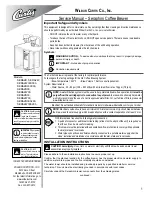
Rev 8.0/6-13
15
MRTALPCH6-DC: #35054
WARNING: Keep apply function activated throughout lift.
Note: If a vacuum pad has been lying against a hard object (as during shipping), it may be
slightly distorted. Although initially it may be difficult to apply the pad to a load, this condition
should correct itself with continued use.
Reading the Vacuum Gauges
The lifter is equipped with 2 vacuum gauges, which indicate the current vacuum level in each
circuit of the lifter’s vacuum system. The
green range indicates vacuum levels sufficient for
lifting the maximum load weight, whereas the
red range indicates vacuum levels that are
not
sufficient for lifting the maximum load weight. Both gauge needles should show a sudden surge
in vacuum as the vacuum pads seal against the load. If it takes more than 5 seconds for the
vacuum level to reach 5" Hg [-17 kPa] on either vacuum gauge, press on any pad that has not
yet sealed.
Vacuum Level on Optimal Surfaces
When the lifter is attached to clean, smooth, nonporous load surfaces, it should be able to
maintain a vacuum level in the green range on both vacuum gauges, except when used at high
elevations (see SPECIFICATIONS: Operating Elevation). If not, make sure the vacuum switch is
adjusted correctly (see MAINTENANCE: V
ACUUM
S
WITCH
A
DJUSTMENT
). If the vacuum switch
cannot be adjusted to maintain a vacuum of 16" Hg [-54 kPa], perform the V
ACUUM
T
EST
(see
MAINTENANCE) to determine whether there is a deficiency in the vacuum generating system.
Vacuum Level on Other Surfaces
When the lifter is attached to contaminated, rough or porous load surfaces, it may not be able to
maintain a vacuum level in the green range on both vacuum gauges, due to leakage in the seal
between the vacuum pads and the load surface.
11
In the case of contamination, thoroughly
clean the contact surfaces of the load and the vacuum pads (see MAINTENANCE: V
ACUUM
P
AD
M
AINTENANCE
: Cleaning), and reapply the lifter to the load. If the load has rough or porous
surfaces,
the operator must conduct a test to determine whether the lifter is designed
to lift the load
, as follows:
1) Make sure the lifter's vacuum generating system is functioning correctly (see MAINTENANCE:
V
ACUUM
T
EST
).
2) Apply the vacuum pads to the load as previously directed.
3) After the vacuum pump stops running, place the lifter's power switch in the OFF ( )
position.
4) Raise the load a minimal distance, to assure that it is supported by the lifter.
5) Monitor both vacuum gauges while the load is suspended for 5 minutes:
The lifter must
maintain a minimum vacuum level of 10" Hg [-34 kPa] during this time.
If not, the
load does not possess the characteristics required for using this lifter.
12
11
Contaminated loads can also cause the vacuum pump to run frequently or continuously. Since excessive pumping quickly
reduces battery energy, the operator should clean the load when possible, to minimize pumping.
12
Certain load materials are too rough or porous to allow the lifter to form a seal which can be maintained for 5 minutes
without power. However, in geographical locations where CE Standards do not apply, it may be possible to use the lifter to lift
such loads. Contact Wood’s Powr-Grip for more information.
Summary of Contents for Powr-Grip MRTALPCH610DCO
Page 2: ......
Page 36: ...Rev 8 0 6 13 34 MRTALPCH6 DC 35054...
















































